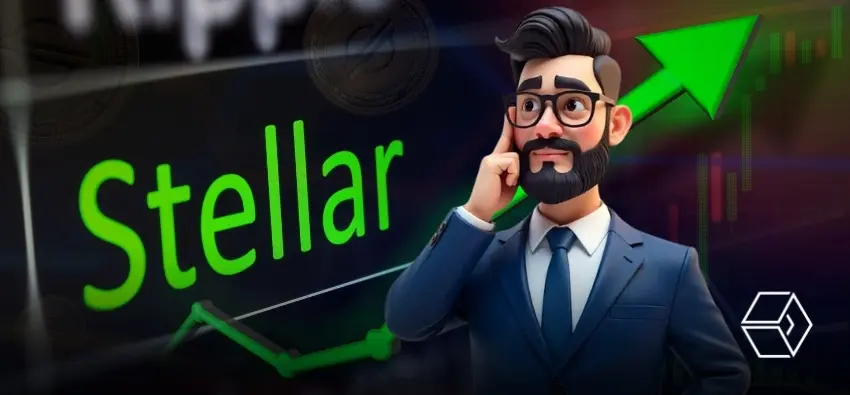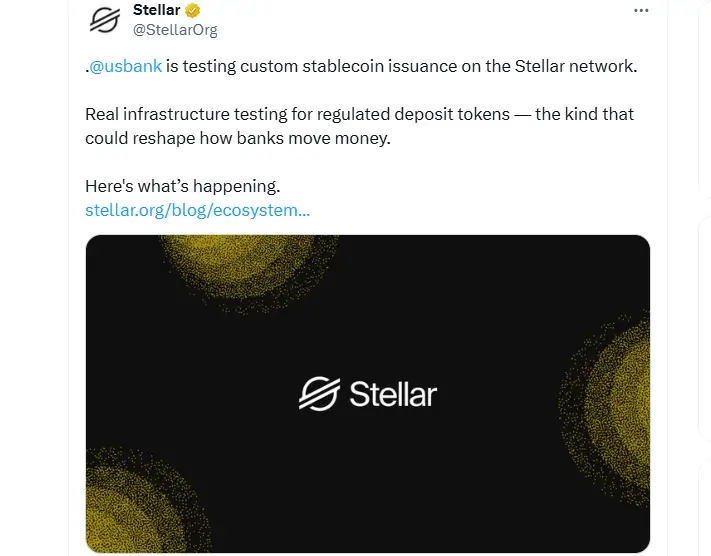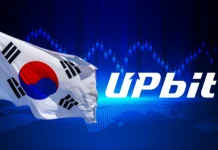
- U.S. Bank pilots a custom stablecoin using Stellar’s fast and compliant blockchain rails.
- Built-in freeze and unwind tools position Stellar for regulated deposit-token use cases.
- PwC and SDF back the pilot as institutions move toward programmable money adoption.
U.S. Bank has launched a new pilot to test the issuance of custom stablecoins on the Stellar blockchain, marking one of the strongest moves yet by a major U.S. financial institution toward programmable, compliant digital money. The initiative, developed in joint efforts with the Stellar Development Foundation (SDF) and professional services firm PwC, was revealed during the bank’s Money 20/20 podcast episode, The Tokenized Future of Banking.
U.S. Bank Tests Stellar Stablecoin in Pilot With PwC and SDF (Source: X)
The pilot focuses on whether a regulated commercial bank can issue and manage deposit-backed tokens on a public blockchain while maintaining the same safeguards applied to traditional banking systems. According to U.S. Bank, the early findings show promise, pointing to stronger control features and operational reliability than previous blockchain tests.
Why Stellar Was Selected for the Pilot
Mike Villano, Senior Vice President and Head of Digital Asset Products at U.S. Bank, said the platform’s built-in safety tools were central to the decision. The bank’s research highlighted the need for controls that mimic traditional banking requirements, including the ability to reverse, freeze, or unwind transactions when necessary.
“For bank customers, we have to think about protections around know-your-customer, the ability to unwind transactions, the ability to claw back transactions,” Villano said during the podcast. “One of the great things about the Stellar platform… was learning that they have the ability at their base operating layer to freeze assets and unwind transactions.”
Stellar’s core architecture was originally designed for issuing assets and moving money across borders. The network records 99.99% uptime over more than a decade, settles payments in three to five seconds, and processes transactions at a fraction of a cent. According to SDF, these parameters offer the reliability demanded by institutional players who intend to move consumer funds at scale.
Institutional Confidence in Public Blockchain Infrastructure
José Fernández da Ponte, President and Chief Growth Officer at SDF, underscored the importance of operational certainty in banking environments. He noted that mission-critical financial systems require infrastructure that does not fail, especially when dealing with retail payments and settlement flows.
“When you are doing mission-critical systems, when you are doing financial services, and you are moving consumers’ money, you need to make sure that your blockchain is going to be there,” he said.
Fernández da Ponte added that SDF takes the trust shown by U.S. Bank and PwC “very, very seriously,” framing the coalition as a shift from theoretical exploration to practical, scalable implementation. Beyond technical reliability, the pilot comes at a moment when institutions are accelerating their exploration of tokenized assets.
Global stablecoin market capitalization has surpassed $280 billion, according to a European Central Bank report published this week. Dollar-backed stablecoins dominate the sector: Tether’s USDT stands at $184 billion and USDC at $75 billion. As cross-border payment demand increases, some analysts project that stablecoin payment volumes could reach $1 trillion annually by the end of the decade.
The Broader Push Toward Digital Banking Infrastructure
For U.S. Bank, the experiment represents a controlled step into real-world digital asset operations. The bank intends to test whether regulated deposit tokens can deliver faster settlement, lower-cost transfers, and 24/7 operational availability while remaining compliant with traditional oversight frameworks.
The long-term potential extends beyond stablecoins. Deposit-backed tokens may serve as the foundation for a broader tokenized asset system that includes loans, securities, and other financial instruments. PwC, serving as a strategic partner on the initiative, is expected to guide regulatory alignment and enterprise-grade system design.
On the other hand, the Stellar Development Foundation says the pilot aligns with its mission to create more inclusive and interoperable global financial rails. By integrating banks into public blockchain infrastructure, SDF believes a new model of digital banking can emerge, one built on transparent, programmable settlement layers.
The initiative signals a broader industry transition: major financial institutions are no longer exploring blockchain in isolation but are actively joining hands with established public networks to test immediate, real-world applications. With U.S. Bank, PwC, and SDF now jointly moving programmable money toward commercial reality, the next phase of digital banking infrastructure appears to be taking shape.











